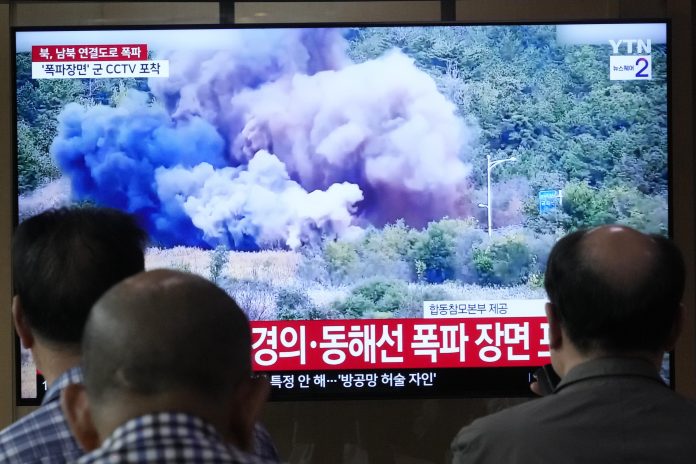North Korea has blown up sections of roads and railways on its territory in the fortified border zone with the South, the South Korean military announced on Tuesday, an act that escalates tensions on the Korean Peninsula..
Around noon, certain northern parts of the roads and railway lines leading south were blown up, the Joint Chiefs of Staff of South Korea reported, according to Reuters.
In response, the South Korean military fired warning shots south of the military demarcation line that separates the two countries, although the blasts did not cause damage on the Seoul side of the border, they stated.
The explosions occurred after Pyongyang committed last week to completely sever inter-Korean road and rail connections and further strengthen areas on its side of the border.
Seoul had been warning since Monday that the North had sent its military to blow up border roads leading to the South.
North Korea has already installed mines and barriers along the border, and on Monday additional work was observed being carried out with heavy equipment, the Joint Chiefs of Staff of South Korea reported.
The South has increased surveillance measures and readiness levels following the incident, they stated.
High tensions after North accused of dropping leaflets from drones
On Friday, North Korea accused South Korea of sending drones to disperse a ‘huge number’ of anti-North leaflets over Pyongyang, claiming it is a political and military provocation that could lead to armed conflict.
Lee Sung-jun, a spokesperson for South Korea’s Joint Chiefs of Staff, declined to answer on Monday when asked who sent the drones, the military or South Korean civilians?
In other statements over the weekend, North Korea warned of a ‘terrible calamity’ if it is discovered that South Korean drones are again flying over Pyongyang.
On Sunday, North Korea announced that it had deployed eight fully armed artillery units at the border ‘ready to open fire.’.
The South Korean military explained that its refusal to respond to questions regarding the drones is because reacting to what the North claims would mean being drawn into a tactic by Pyongyang to invent excuses for provocations.
Lee Kyoung-haing, a military drone operations expert at Jungwon University, explained that civilians would have no problem obtaining drones with a range of 300 kilometers, the round trip distance from the South to Pyongyang, carrying light payloads such as leaflets.
On Sunday, the North Korean Ministry of Defense asserted that the drones, which it claimed were detected over Pyongyang for three days earlier this month, are of a type that require a special launcher or a runway, and that it is impossible for a civilian organization to launch them.
The two countries are technically still at war
North Korean leader Kim Jong Un presided over a meeting with defense and security officials on Monday to discuss how to respond to ‘the serious challenge from the enemy that has violated the sovereignty of the country,’ state news agency KCNA reported.
Technically, the two Koreas are still at war since the conflict from 1950-1953 ended with an armistice, not a peace treaty.
Cross-border ties have emerged during periods of rapprochement between the two countries, including the 2018 summit between the leaders of the South and the North when they declared that there would be no more war and that a new era of peace had begun.
North Korea has reintroduced heavy weapons into the demilitarized zone and reinstated guard posts after both sides stated that the military agreement from 2018 intended to reduce tensions is no longer valid.


